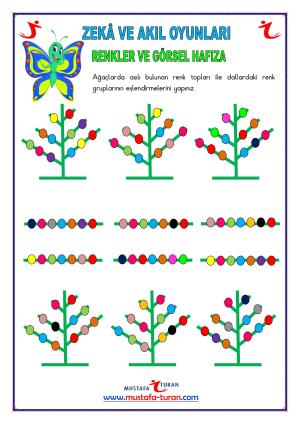Colors and Visual Memory Activities-50
Colors and Visual Memory Activities Series Dear Visitor; Our aim in these studies is to observe the color blindness conditions in our children or students. If your student or child experiences serious problems and color confusion in the activities we have prepared, we recommend that you consult an ophthalmologist who is an expert in this field. We recommend that you read the article on COLOR BLINDNESS prepared by Medical Park Hospitals regarding color blindness. COLOR BLINDNESS Color blindness is used to describe impairment in perceiving different colors and shades. It is a very common condition, seen in more men than women. Although it is encountered at a rate of 0.6 – 0.8 percent in women, this rate is approximately 10 percent in men. The cause of this disease is; It is the lack or absence of some pigments in the retina layer of the eye. Color blindness can be mild, such as difficulty distinguishing shades of the same color, or it can be so severe that it is not possible to distinguish any color at all. The most common type is the inability to distinguish red from green. In some rare cases, all colors cannot be distinguished and the world appears in black and white. One in every 20 men and one in every 200 women has it. Most people do not realize that they are color blind. WHO HAS COLOR BLINDNESS? 8 percent of men and less than 1 percent of women have color blindness. Most color blindness is present at birth. However, in some people with color blindness, the disease is not inherited. While the lens is clear at birth, it darkens with age. Medications used and disorders in the optic nerve can cause color blindness. WHAT ARE THE SYMPTOMS OF COLOR BLINDNESS? In hereditary color blindness, which is the common type of color blindness, green, yellow, orange and red are perceived in the same way and individual colors can only be distinguished by their intensity. Since this disorder is congenital, color blind people may become able to distinguish certain tones over time. In the rare and serious type of color blindness, vision impairment is progressive and the patient sees everything in black and white. Color blindness does not cause a significant problem in daily life, but the patient cannot work in certain tasks related to colors. Since red and green colors are widely used in land and sea signs all over the world, color blind people cannot drive or sail. Since important warnings are made in these colors, not seeing them can be life-threatening. HOW IS COLOR BLINDNESS DETECTED? Children with severe difficulties should be checked for eye problems, including color blindness. People who have a family history of color blindness, those who have to distinguish colors in their work, or those who have problems distinguishing colors should be examined in this respect. CAN COLOR BLINDNESS BE TREATED? There is no cure for hereditary color blindness. Color blindness, which is caused by the weakening of the optic nerve and is accompanied by visual impairment, can be corrected to some extent or at least its progression can be prevented. Color blindness is harmless when it is congenital, and many people do not even realize they are color blind for a long time; The condition can only be revealed with an eye examination. The change in the ability to distinguish colors may also be due to eye disorders. In this case, it is best to go to an ophthalmologist and get treatment.



